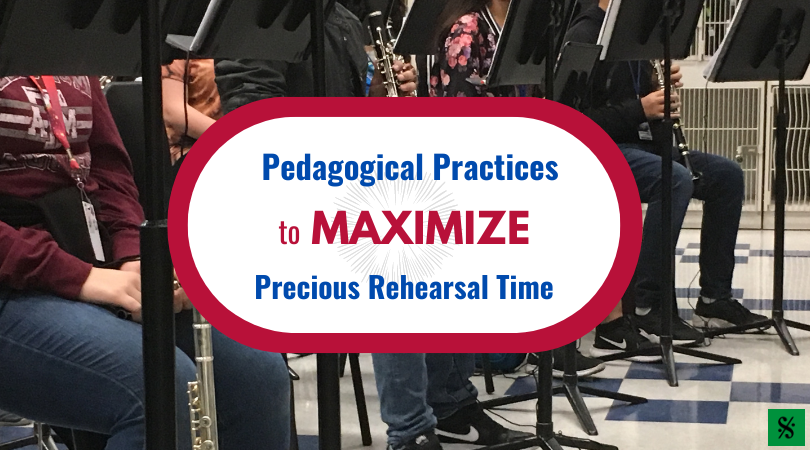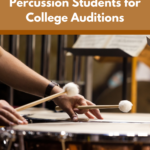The college audition process is one that takes place every school year. The college audition can be an extremely daunting process for many students. Knowing how to prepare for that upcoming audition properly is one area that many students and non-percussion directors might struggle with at times. Being a percussionist means being able to perform at a high level on multiple percussion instruments. Many colleges and universities ask students to prepare multiple items such as rudiments, major and minor scales, snare etudes, rudimental solos, two and four-mallet solos, and timpani etudes. Here are some specific things that all students should know and practice to help them prepare to have a good percussion audition so that they can hear those magic words, “You’re accepted, we would like to offer you a scholarship.”

Step 1: What to know and research
- What school or schools are you looking to attend?
- What are the audition requirements for that school?
- Does the school have a percussion instructor?
- Does the school or schools have scholarships available for percussionists?
- What dates are available to audition?
It is essential for the student to do their research on the school they are planning to attend. Researching the school will allow the students to better understand what specific things are being asked of students to audition. It is essential to know each school’s audition requirements as each college or university requirement might differ. Also, researching schools will give the student a heads-up on determining which place would be a good fit for that student’s educational needs. It is better to be prepared and even over prepared than to not have any information on your upcoming audition.
Step 2: Rudiments to Prepare
There are 40 standard rudiments that all percussionists should know. The rudiments are broken down into four main sections. The sections are: rolls, paradiddles, flams, and drag rudiments. It is suitable for students to perform at least two rudiments from each section to show flexibility in playing ability. Rudiments to perform from each section for an audition are:
- Buzz Roll
- 5 Stroke Roll
- Single Paradiddle
- Paradiddle
- Flam tap
- Flamacue
- Drag
- Ratamacue
- Students can find additional help on rudiments online from multiple sites such as: https://vicfirth.zildjian.com/education/40-essential-rudiments.htm
Step 3: Major and Minor Scales
Scales are a stepwise arrangement of notes that are contained within an octave. Each scale, major and minor, has seven notes or scale degrees that are played. Major scales have a half step between scale degrees 3-4 and 7-8 while having whole steps between all the other couples of notes. Minor scales can be played in three forms: natural, harmonic, and melodic. The natural minor scale has a half step between scale degree 2-3 and 5-6. The harmonic minor scale has a half step between scale degree 2-3, 5-6, and 7-8. Finally, the melodic minor scale comes in two forms: ascending and descending. While ascending the melodic scale has a half step between 2-3 and 7-8 and while descending there is a half-step between 2-3 and 5-6. Students should practice to play the scales two octaves in a pattern of quarter notes, eight notes, or sixteen notes.
Step 4: Snare
When picking a snare etude, students should look for a piece that displays technique, dynamics, rudiments, and musicality. Students should also look to find a piece that ranges from 2-3 minutes long. Avoid long pieces to ensure there is enough time to complete the entire audition. There are multiple snare drum books available to showcase a student’s playing ability.
- Portraits in Rhythm – Anthony J. Cirone
- Etudes for Snare Drum – Mitchell Peters
- Intermediate solos for Snare Drum – Patrick Moore
- Alfred’s Complete Snare Drum Solos – Sandy Feldstein & Dave Black
- 14 Modern Contest Solos for Snare Drum – John S. Pratt
Step 5: Mallets
For many younger students, playing mallets can be difficult due to playing melodic passages, but it is essential that every percussion student develop a background in mallet percussion. When picking a mallet etude for a college audition, the student should pick a piece that ranges from 2-3 minutes long, uses the full range of the mallet instrument, and should showcase the student’s strength. It is good to perform pieces from the state’s All-Region, All-District, or All-State selection. These etudes usually allow the student to showcase the use of rolls and different rhythm patterns. There are multiple mallet books in which a student can use to study from to show their skill level on mallets.
- Cello Suite No. 1 by J.S. Bach, Transcribed for marimba by Mario A. Gaetano
- Mallet Studies and Melodious Etudes: Level 1 by Sandy Feldstein
- Modern School for Xylophone, Marimba, and Vibraphone by Morris Goldenberg
- Fundamental Solos for Mallets by Mitchell Peters
Step 6: Timpani
Performing timpani for an audition is essential as it shows the students ability to hear specific pitches by tuning drums, play on multiple drums, use different techniques to help create a fluent sound. When preparing your percussion students for their college audition select timpani pieces that utilize 2,3, or 4 drums. The timpani piece should be 2-4 minutes long and the timpani piece should utilize multiple rhythms, rolls, and dynamics. Besides using All State or All Region etudes there are multiple resources available for the percussionist that deliver great timpani solos for auditions.
- Fundamental Solos for Timpani by Mitchell Peters
- Timp-Tastic: A collection of 10 Timpani solos for 2,3, & 4 Drums by Lalo Davila
- Audition Etudes by Garwood Whaley
- Exercises, Etudes, and Solo for the Timpani by Raynor Carroll
Additional Tips
- Schedule a private lesson before the audition with the percussion teacher at the school the student is looking to attend
- Bring in percussion teachers to conduct master classes
- Remember when auditioning that the performance quality is more essential than the difficulty of music performed
- Always double check what instruments will be available for the audition
- Bring two copies of music to the audition. One copy for the student and one for the audition committee
- Arrive at least 15-20 minutes early to the audition to allow time to warm up and adjust to the instruments
- Have fun and enjoy the process
Patrick Moore is an active percussion performer, educator, arranger, adjudicator, and clinician. He is a versatile percussionist with experience in many areas of percussion. Patrick is an education endorser of Vic Firth Sticks and Mallets, and Majestic percussion. Professor Moore is a published author having works published with Alfred Publishing Company and Kendor Music. He has presented clinics at numerous music education conferences in the United States as well in Guatemala. Currently, Moore is the Director of Bands at South Carolina State University in Orangeburg, South Carolina. He received his Bachelor of Music from the University of Arkansas, Masters from Texas Tech and is also pursuing his Ed.D from Abilene Christian University.
Related Reading:
The Percussionist’s Etiquette
Five Minute Drill – Fun Classroom Routines for Percussion
YouTube Finds – Percussion
If you would like to receive our weekly newsletter, sign up here.
Don’t forget to like us on Facebook too!
Learn. Share. Inspire.
BandDirectorsTalkShop.com






Leave a Reply
You must be logged in to post a comment.